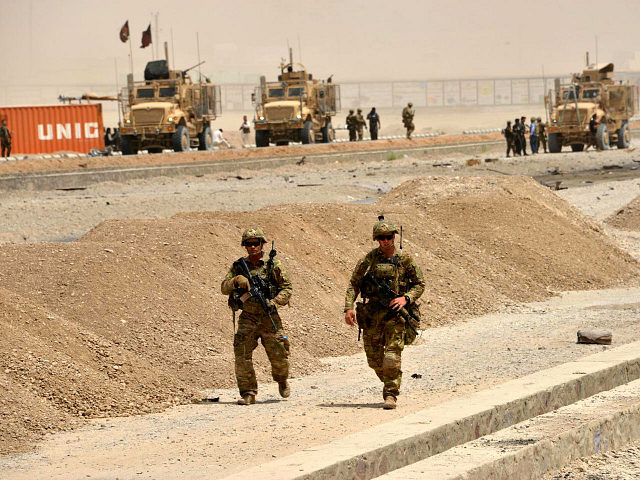While the U.S. could send as many as 4,000 more troops to Afghanistan, NATO members are considering sending less than half of that, according to several officials.
President Trump has approved sending up to 3,900 U.S. forces to implement the new strategy, but NATO members have so far pledged between 1,000 to 2,000, according to a spokesman for the U.S.-led coalition in Afghanistan.
“Roughly, yes, that is,” said Swedish Royal Navy Capt. Jon Dunmurray, when asked if that was the ballpark figure. “[It’s] something in that area.” A U.S. official in Afghanistan confirmed that discussions have been in that range.
Any new NATO forces would not likely arrive until 2018, Dunmurray said. Meanwhile, more U.S. forces are expected within weeks, the U.S. official said.
NATO Secretary-General Jens Stoltenberg on Tuesday said the alliance and other nations contribute about half of the forces for the mission to advise-and-assist Afghan forces and that he expected that to continue.
Currently, the numbers on paper do show rough parity between U.S. and other coalition members for that mission, which is led by the U.S. but under the auspices of NATO.
According to the latest statistics from May, there were 6,941 U.S. forces, and 6,635 non-U.S. coalition forces part of the joint mission — with 4,980 of that specifically from NATO members and the rest from non-NATO partner forces.
But according to a U.S. official, the number of actual NATO bodies on the ground is much lower — “closer to 4,000.”
In June, about 15 of 29 NATO members offered to send “several hundred” more forces to Afghanistan — but just to fulfill current unmet obligations, according to the Wall Street Journal.
Defense Secretary James Mattis alluded to this gap when he visited Brussels in June. “We still have a few gaps and nations are stepping up,” he said.
Even if the gap is closed, and somewhere between 1,000 and 2,000 more NATO forces are deployed, that would leave the alliance far below what the U.S. is expected to deploy.
There are currently 8,400 U.S. troops in Afghanistan — about 7,000 part of the NATO advise-and-assist mission and 1,400 part of a counterterrorism mission.
With as many as 4,000 more forces deploying, and another 3,500 who are deployed on a temporary basis as recently revealed by the WSJ, the grand total of U.S. troops on the ground could be around 16,000.
Dunmurray said some NATO and partner nations have not decided yet whether to send more forces and that some new nations may join the 39-nation coalition in Afghanistan in the near future.
President Trump unveiled his plan on Monday, weeks after it was expected, and Mattis was expected to talk with the NATO chief in the coming days after the announcement.
Some doubt NATO will even send between 1,000 to 2,000 forces for the new plan.
“It would surprise me if they upheld that minimal commitment,” said Nicholas L. Waddy, associate professor of History at the State University of New York at Albany.
“The simple fact of the matter is most other NATO military forces are chronically underfunded, so they’re literally incapable of mounting military operations, especially projecting power overseas, so unfortunately it was to be expected that we would carry most of the burden,” said Waddy.
Trump made calling on NATO to spend more on their own defense a part of his campaign platform. He called on members to meet the alliance obligation of spending at least 2 percent of GDP on their own defense. Only five members meet that commitment.
The Heritage Foundation’s James Carafano, who worked on Trump’s transition team, defended NATO, saying they were waiting to hear from the U.S. what the plan was before committing troops.
“I think largely what they’ve been really waiting for for the last six months is a clear sign of direction from the United States,” said Carafano, E.W. Richardson Fellow and vice president for the Kathryn and Shelby Cullom Davis Institute for National Security and Foreign Policy.
He also said it wasn’t realistic to ask NATO to do much more. “We all have a common interest to do this and other people need to step up, but they need to step up realistically in their capability,” he said.
But Waddy also thinks it’s a matter of political will to build up that capability.
“They have the resources, they have money, they have the people, they have the technology, they just don’t have the will,” he said. “It’s something that’s bothered many Americans for a long time.”
The Center for the National Interest’s Director of Defense Studies Harry Kazianis said NATO could play a bigger counterterrorism role in Afghanistan.
“We need to make sure another 9/11 does not get planned from this war-torn nation. And NATO should play a big role in that,” he said. “I do think a small, rapid reaction style force from NATO that is capable of targeting and attacking terrorists cells in Afghanistan makes a lot of sense.”
“It also dovetails nicely with Trump’s promise to the American people to ask more from our allies—they have a big interest in making sure Afghanistan is stable and taking on some of the burden.”

COMMENTS
Please let us know if you're having issues with commenting.